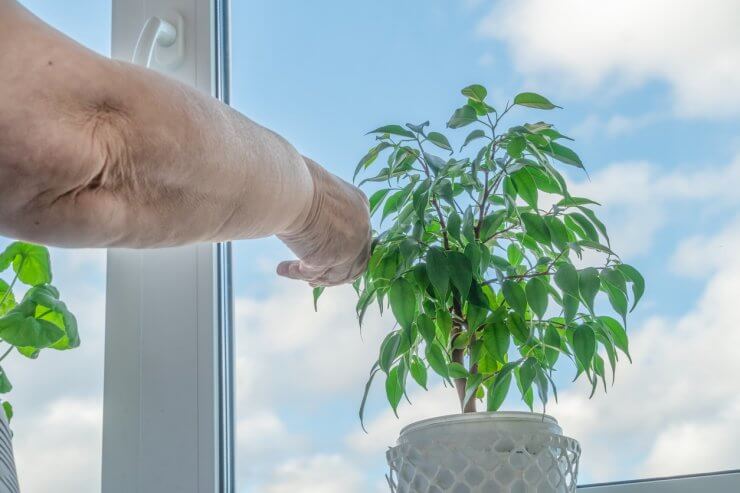
Young Lemon Tree Indoors.
Compact fruit trees deliver full-size harvests without taking over the yard. Powered by genetics and dwarfing rootstocks, these trees bear fruit early and stay easy to prune, stake and pick. Put the science to work and match the right tree to the right spot for fast, reliable crops.
What Causes Dwarfing in Fruit Trees?
Dwarf trees look and act differently at the tissue level and in the canopy. They tend to have shorter internodes, reduced apical dominance, darker and thicker leaves with a smaller total leaf area, and fewer shorter roots. Under a microscope, dwarf plants show fewer stem cells yet higher cell density. These traits translate into compact growth that’s manageable in tight yards.
Plant anatomy tells only half the story. In orchards, you usually create dwarf trees by grafting a desired variety — the scion — onto a size-controlling rootstock. The scion sets fruit size, color and flavor, while the rootstock limits height, speeds up first fruiting, and adds stress or disease tolerances.
Genetic Dwarfs Versus Grafted Dwarfs
You can buy true genetic dwarfs or trees grafted onto dwarfing rootstocks. Grafted dwarfs often appear in nurseries but usually need a strong stake or trellis for life. Genetic dwarfs stay sturdier and frequently stand on their own.
Why Dwarf Trees Still Produce Normal-Sized Fruit
Rootstocks control tree size and bearing age, not the inherent fruit size of the variety. The scion keeps the fruit’s genetics. For example, a dwarf Honeycrisp apple still gives you a full-size variant when you grow it well.
You also see faster timelines. Many dwarf trees bear fruit in two to three years. Semi-dwarf apples and most pears often need four to five years, while standard apples can wait seven to 10 years. Peaches, plums and cherries typically start in three to four years. Plan spacing and pruning with those timelines in mind.
Soil Types That Work With Dwarf Fruit Trees
Fruit trees grow in sandy, loamy or clay soils when you provide drainage and match varieties to the site. For most tree fruits, aim for a soil pH around 6.0-6.5, and confirm with a test before you amend anything.
Clay holds water and nutrients well, but it drains slowly. Pears tolerate heavier or wetter soils better than many tree fruits, so they often outperform peaches or apricots on sites with clay. If you garden in clay, build mounded beds, add organic matter and choose rootstocks that handle heavier dirt.
For irrigation planning, remember that fine-textured soils store more water but release it slowly to roots. Use that to set longer, less frequent watering, then adjust by observing growth and ground moisture.
The Physiology That Keeps Dwarf Fruit Full-Sized
You may worry that a smaller tree makes smaller fruit. The scion dictates fruit size and quality, not the rootstock. Dwarfing rootstocks reduce canopy vigor and increase precocity, but the fruit’s genetics stay the same — which is why compact trees still deliver full-size harvests when you meet light, water and nutrient needs.
Heat, Sun and a Mineral That Helps
Summer heat can sunburn fruit and stress leaves. Kaolin clay particle films, when applied correctly and at the right times, can reflect light, cool canopies, and reduce heat stress and insect activity.
You also see a unique material property behind those sprays. Kaolin is chemically inert with a neutral pH, and hydrogen bonds between its crystal layers block water from entering, which makes kaolin non-swelling. That stability helps it behave consistently in mixes and films.
Popular Dwarf Fruit Trees You Can Plant at Home
You have many good options for planting. Here are dependable choices that home growers use widely.
- Dwarf apple: Choose a reputable dwarfing rootstock and a disease-resistant variety for your climate. Dwarf apple varieties bear quickly and fit tight spaces.
- Sweet or tart cherry on Gisela dwarfing rootstocks: Gisela 5 and related rootstocks keep trees compact and productive, which suits small yards and “pedestrian” orchards.
- Genetic dwarf peach or nectarine: Several genetic dwarfs stay compact and look ornamental while still fruiting. Support early growth and protect blossoms from late frosts.
- Semi-dwarf pear: Compact pears offer manageable height, good yields and better clay tolerance than many stone fruits.
- Blueberries: You can grow blueberries in a pot — keep them nourished monthly with ericaceous liquid fertilizer and repot them every two years.
Tips for Dwarf Tree Growing Success
Use this checklist to set up your tree for consistent crops.
- Match the rootstock to your site: Pick size-controlling rootstocks that fit your space, soil drainage and disease pressure. You speed up first fruiting and cut ladder work.
- Stake what needs staking: Support most grafted dwarfs with a sturdy stake or trellis from day one. Keep ties snug but not tight. Genetic dwarfs often stand alone.
- Plant where the sun stays: Give trees at least six hours of direct sun. Prune to keep an open canopy that ripens fruit evenly.
- Water based on soil, not by calendar: In loams or sands, let the top few inches dry between deep waterings. Water less often in clay and monitor soil moisture.
- Dial in pH and nutrients: Test soil — aiming near pH 6.0-6.5 for most tree fruits — and feed according to extension guidelines rather than guesswork.
- Prevent sunburn on hot sites: Consider kaolin particle films before peak heat. Reapply per label if rains wash the film off.
- Know your timeline: Expect first crops on dwarfs in about two to three years, on semi-dwarfs in four to five, and on standard apples much later. Thin early crops to protect the structure.
- Choose container-friendly species when needed: Citrus, figs and many apples thrive in large containers with a quality mix and regular feeding.
Next Steps for Your Mini Orchard
Pick one dwarf variety that fits your climate, then choose a rootstock sized for your space and soil. Plant in full sun, stake grafted trees and set a simple pruning goal for year one. Monitor what works with quick notes on watering, pruning and fruit set. You’ll learn fast, harvest sooner and turn a small corner of the yard into a steady source of fresh fruit.



